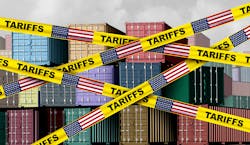42% of Exporters Expect Revenue Drop Due to Tariffs
Exporter confidence is down according to the newly released Allianz Trade Global Survey. The report notes that the unpredictability of US trade policy has caused 42% of exporting companies to expect revenue to decline between -2% and -10% over the next 12 months, compared to fewer than 5% before the trade policies took effect.
The survey reveals that close to 60% of firms expect a negative impact, with less than half of companies expecting positive export growth, compared to 80% before the new trade policies.
Production could also be hit, with 27% of firms saying that they could stop production temporarily as foreign exchange (FX) volatility exacerbates the cost of higher tariffs, and 32% intend to stop imports or offshore production to avoid delays or increased costs.
Other key findings include: (excerpted below)
Diversification to mitigate the impact of the trade war: around one-third of companies have already found new markets for exports and supply, and almost two-thirds are planning to do so. On the supply side, for companies strongly integrated into global supply chains, geopolitical risks and the trade war are top-of-mind and are provoking reconfigurations: Over the whole sample, 54% of respondents consider geopolitical and political risks and social unrest among the top three threats to their supply chains.
Such risks as well as tariffs and trade restrictions, are pushing companies to rethink their supply chains. Even before the policy change, our survey shows that 34% of respondents had already found new locations for their offshore production sites and/or suppliers, and 59% were planning to do so. This is even more evident for US firms that have longer supply chains and a larger share of production abroad, with nearly 60% of them having already found relocation destinations.
More than half of exporters anticipate longer payment terms, with delays to exceed seven days in half of the cases. Only 11% of export companies continue to be paid within 30 days, but this figure is notably lower among top exporters like the US, China and Germany.
Approximately 70% of companies receive payments between 30 and 70 days, with the UK (75%), France (73%), Italy (73%) and the US (73%) slightly more numerous than peers. Sectors such as retail, computers and telecom, construction and automotive report payment terms below 50 days on average, while transport equipment, energy, electricity, metals, paper and agrifood experience longer terms (above 50 days on average).
Larger firms tend to experience longer payment delays, with 26% of surveyed companies having a turnover above EUR5 bn facing payment terms exceeding 70 days, compared to 18% for the overall sample average.
Even though the new trade deal brings the US average import tariff rate on China to 39%, down from 103%, this is still much higher than the 13% applied before the second Trump administration. As a result, US firms will likely continue to frontload imports as a strategic response, alongside rerouting shipments. Before tariffs kicked in, 79% of American companies raced to frontload shipments from China, with a proactive 25% having started before the November 2024 election, especially in sectors such as agriculture, machinery and metals, while those in agrifood and computers dragged their feet.
After the policies, most firms said they would seek alternative shipping routes to keep customs costs under control, notably 62% in the US. Rerouting is being facilitated by lower shipping costs, which have dropped by almost 50% since the beginning of the year. Despite the US-China deal, we believe rerouting will continue as a mitigation strategy as the tariff rate on China remains significantly higher than that applied on emerging trade hubs like Southeast Asia, the UAE, Saudi Arabia and Latin American countries.
Firms are pushing costs on others: from raising prices on their customers to leaving customs duties to their suppliers. Despite recent positive developments, price hikes are likely to remain the go-to strategy globally to counter tariff impacts, especially in the US, where 54% of firms said they would do so after the policy change (compared with 46% before).
Firms in general are also trying to push the cost and responsibility of customs duties onto their suppliers: Our survey shows buyers’ Incoterms preferences moving towards “Delivered Duty Paid” globally, thereby leaving to the seller the responsibility to manage logistics and costs (including customs) all the way to buyer’s locations. An interesting exception is in the US, where “Cost, Insurance & Freight” remains king. Companies also want to share the cost of FX volatility, with 59% choosing the introduction of pricing clauses in contracts to share FX risk with clients and suppliers as their preferred option.
The trade war is creating opportunistic friendshoring: the Europe-Asia rapprochement. Amidst the US-China tensions, Europe is emerging as an attractive alternative. Following “Liberation Day”, when asked about regions that present the most export opportunities, around a quarter of Chinese firms with supply chains in North America picked Europe (up from around 15% before the policy change). European firms are also increasingly interested in exporting to China and Asia: Between both surveys, export intentions increased by 6pps (30% to 36%), and the interest towards the South and Southeast Asian market doubled (7% to 14%) as trade links between the region are intensifying with more free-trade agreements.
A similar increase in preference can be observed when it comes to supply-chain exposures. Following the policy changes, fewer German firms with offshore production sites or suppliers in China were considering relocating elsewhere (50% vs. 67% before the policy change), and Asia-Pacific has become the preferred relocation destination (43% vs. 28% before the policy change) for German firms with current supply-chain exposure in North America. In comparison, the share of German firms choosing to stay in North America has not changed before and after the policy changes (roughly 30%).
